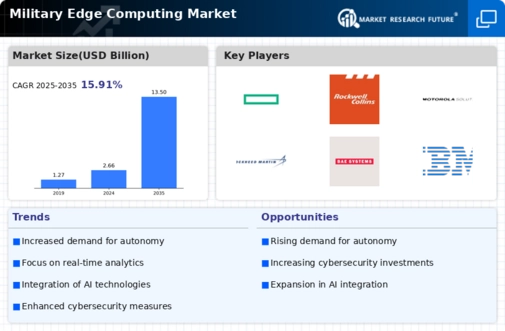The Global Military Edge Computing Market is emerging as a critical sector with growing significance due to the increasing need for enhanced data processing, analytics, and decision-making capabilities within military applications. In this competitive landscape, multiple players are striving to establish and maintain a foothold by leveraging advanced technologies, innovative solutions, and strategic partnerships.
As military operations become increasingly reliant on real-time data and advanced technological deployments, edge computing is poised to play a substantial role in ensuring operational efficiency on the battlefield.
The competition is driven by the need for improved cybersecurity, reduced latency in data processing, and the capacity to handle vast volumes of information in mission-critical environments. As military budgets evolve and digital transformation continues, understanding the dynamics of this market is essential for stakeholders aiming to capitalize on emerging opportunities.
Hewlett Packard Enterprise holds a notable position in the Global Military Edge Computing Market due to its robust capabilities in providing scalable infrastructure and innovative edge solutions tailored for defense applications.
The company leverages its strengths in high-performance computing, hybrid IT solutions, and integrated systems to deliver adaptable edge computing platforms that meet the stringent requirements of military operations.
With a strong focus on security and reliability, Hewlett-Packard Enterprise has designed its solutions to ensure data integrity and swift processing for command and control applications. The company's enduring commitment to research and development allows it to stay ahead of technological advancements, maintaining its competitive edge.
Furthermore, Hewlett Packard Enterprise's partnerships with defense agencies and companies enhance its market presence, enabling it to tailor offerings to meet unique operational demands and foster innovation in military edge computing.
Rockwell Collins stands out in the Global Military Edge Computing Market with its deep expertise in aerospace and defense technologies. The company has successfully integrated edge computing capabilities into its suite of military communication and navigation systems, facilitating real-time data sharing and operational awareness among armed forces.
Rockwell Collins emphasizes the development of resilient and effective solutions that cater to the complexities of modern battlefield environments, focusing on enhanced situational awareness and command effectiveness.
By leveraging its background in systems engineering and extensive experience with military platforms, Rockwell Collins excels at delivering tailored edge computing solutions that optimize performance while ensuring interoperability with existing defense infrastructures.
The company's commitment to innovation, paired with its strong integration capabilities, positions Rockwell Collins as a significant player in this competitive market, addressing the evolving needs of military operations through advanced edge computing technologies.


















Leave a Comment